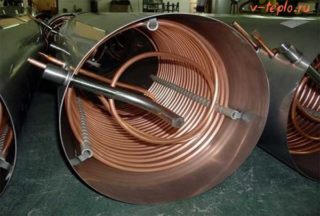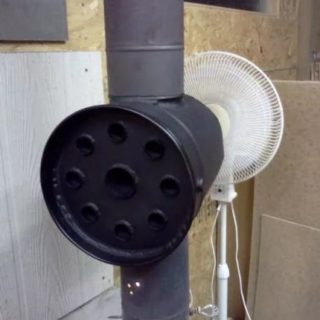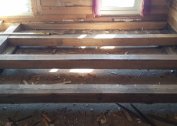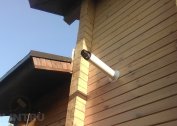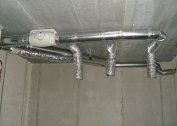A standard heat exchanger for a sauna stove in a chimney helps to save on the purchase of a heating device and use the heat energy to heat water or heat additional rooms. When choosing a device, it is better to study its purpose and principle of operation, the available varieties and installation methods in advance. You can also make such a device yourself, following the step-by-step instructions.
The need to install a heat exchanger in the chimney and the principle of operation
Modern bath stoves are created so that devices can reach the maximum temperature inside the furnace in a short time and keep it at this level for a long time. During operation, a significant amount of unspent heat goes outside with the help of a pipe from the chimney. The heat energy of this plan is suitable for heating water or heating rooms located next to the steam room. It is best to use the heat that is released during the burning of wood, and to supplement the device with a factory or home-made heat exchanger. Such elements for heating water are divided into three varieties:
- a coil on a standard chimney built into the heater;
- heat exchanger for an external chimney, heated from the furnace wall;
- a water circuit that draws thermal energy from flue gases.
The coil is built into the firebox and positioned so that a direct flame does not act on the tube. This element should be placed in the path of the exhaust products of combustion, in which case it will serve as long as possible and will not start to burn. In designs of this type, water will heat up quickly enough, but at the same time, the device will begin to reduce the power of the device for heating. The outdoor device has a simple design and accessibility, while it is not too convenient to maintain and requires constant replenishment of water supplies. Such tanks are suspended from the side of the firebox and heated by infrared radiation from it.
The best option are the stoves of the bathing category with heat exchangers in the chimney, which are flow heaters with a capacity of 5-10 liters. To an element of this type, you can attach a part with an external drive, the volume of which varies between 60-120 liters, taking into account the power characteristics of the device. During heating, the water inside the tank reaches the desired temperature.
Installation methods
The installation of a heat exchanger is easiest to carry out if the element is supplied with the purchased furnace equipment. In this case, it is enough to study the instruction on maintenance of the unit and carry out the assembly taking into account the scheme. When installing a water circuit inside a flue or a brick furnace, the register is made in advance from stainless steel or a thick-walled tube, after which it is built in accordance with the drawing of the heating device.
If the element is made at home, it is better to focus on models of similar devices, finding their technical characteristics and calculating the desired area of the part. A do-it-yourself heat exchanger for a chimney, working as a water economizer, is purchased ready-made or welded from pipes with different diameters.The longer the circuit, the more efficient it will give thermal energy to the chimney.
Heat exchanger classification and purpose
Devices are divided into several varieties, taking into account their main design characteristics and purpose.
At the location of the warm water tank
Tanks can be installed in the steam room, shower room or in the attic, each location has its advantages and disadvantages. In the first case, it is possible to significantly reduce the size of the water supply and speed up the process of heating the water, at the same time it is necessary to consider the area of the room. The most optimal option is to install a tank in the shower, only slightly increasing the length of the pipeline. To solve the problem with a low pressure water jet, it is better to take the container to the attic. This method requires an increase in the number of pipes and provokes heat loss if the tank is not equipped with a heater.
At the location of the heater itself
The heat sink on the bath chimney can be placed in the stove or near the unit, both options are fully available, but at the same time they have characteristic features. The inner element makes it possible to quickly heat water, the only drawback is its rapid boiling. If such a device needs to be urgently replaced, for this purpose it will be necessary to disassemble the furnace equipment. Cleaning the internal heat exchanger also causes problems due to the accumulation of a thick layer of scale on its walls. The part located near the chimney does not have such shortcomings, since the temperature of the tube is not enough to heat water near the walls of the device. It should be borne in mind that in a similar situation, heating will take longer.
Selection rules
Before choosing a standard or air heat exchanger for the chimney pipe, you will need to take into account all the pros and cons of each type. The selection of a suitable device is influenced by its purpose and degree of performance. The simplest option is a coil made of a tube bent into a ring, which is located in the tank. More often, more complex options are used for the bathing furnace equipment, consisting of two containers connected to each other by means of tubes.
In this case, the fuel warms up the lower tank, after which the heat passes to the upper tank. This method makes it possible to heat water, but at the same time to heat the space of the dressing room and steam room. Furnace units with built-in heat exchangers are filled with antifreeze or water. They function due to the natural circulation of liquids due to temperature differences. In this case, there are options equipped with electric pumps.
Chimneys equipped with a duct help to spend the thermal energy of the exhaust gases without spending the one that is released during the heating of the stove. Due to the increase in the volume of the device, the liquid in the tank warms up extremely quickly, and its temperature is kept at a high level.
DIY heat exchanger manufacturing
If necessary, the heat exchanger on the chimney pipe is made with your own hands according to a simple step-by-step instruction. In the process, it is important to comply with all safety conditions and rules, as well as create a structure with maximum safety margin.
Necessary materials and tools
To create a standard heat exchanger like a coil, you need a set of standard pipes, metal sheets for the tank, as well as pipes for supplying and draining water to the tank. The list of tools that should be prepared includes a vice, pliers, a wrench, metal scissors, a flare tool and a welding machine to ensure tight joints.
Calculations
It is quite difficult to make the correct calculations for a device made by hand because of the lack of the ability to regulate the air supply. Another reason is the heterogeneous quality of the fuel, even if the stove is heated with wood of only one type, and a sharp decrease in the heat transfer of firewood at the end of the heating process. For this reason, all heat exchangers are manufactured with an additional margin of strength. If we are talking about self-assembly, steel pipes with a diameter of no more than 3/4 are used for the furnace, for copper coils they are copper analogues, the diameter of which is 10 mm. The approximate length of the element is 1 meter; for steel pipes, a distance of 10-15 cm is distinguished, for copper options it should be much less.
Manufacture
To make a heat exchanger for a sauna stove for a 115 mm chimney, you can use the step-by-step instructions that include the following steps:
- Creating a coil from a copper tube with a diameter of up to 10 mm.
- Flaring of the element at the ends to form a transition to the diameter of the selected tube.
- Cutting exhaust holes in a piece of smoke.
- Installation of bends and a coil.
- Mounting the pipe and other parts to the chimney.
If necessary, make an internal heat exchanger in the furnace to mount steel pipes for which direct bends are suitable. To prevent water from heating in them, indent between each turn. It is additionally recommended to install a circulation pump during the installation of the coil. In the furnace, the device is held by brickwork, in the chimney - with the help of bends, which should have an extremely minimum length.
Before connecting, the system is mandatory tested with cold water, filling it completely and inspecting each element. Even the smallest hole can turn into an impressive leak, so such problems should be eliminated at the installation stage.

